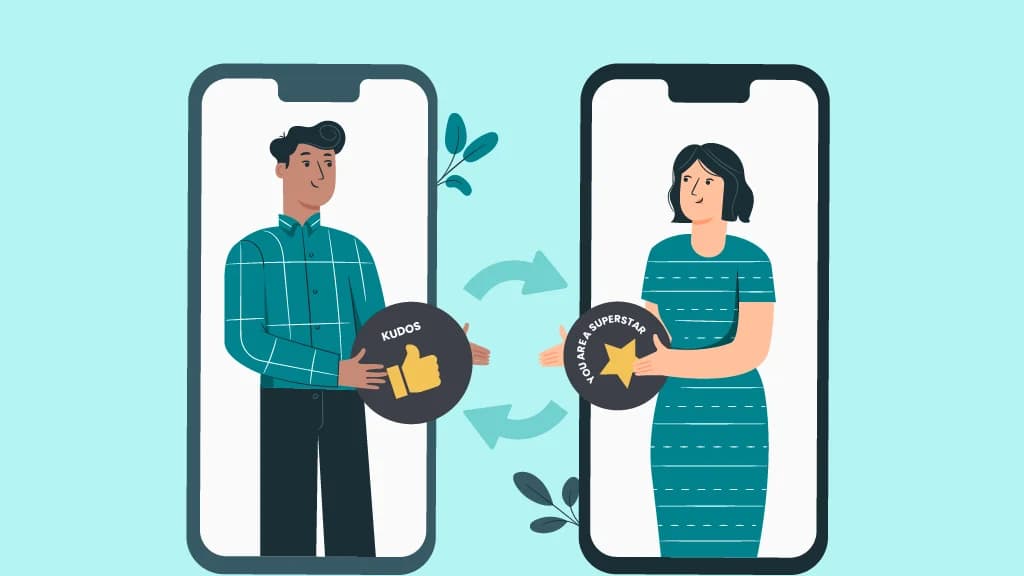
When you recognize and appreciate employees, you’re making your business successful! The situation in the world is different, and workers are already willing to embrace the next chance. But, the truth is that a thank you and the words “you are doing a great job” can have the power to brighten the whole day of your employees and make them stay longer. The effect of the recognition of employees is improved work and better business operations.
As more teams operate remotely or in hybrid settings, timely and clear appreciation has become even more critical. A well-executed recognition program isn’t just a feel-good initiative; it directly contributes to business growth. When we recognize employees who drive results, we invest in those who power the company’s success.
What is Employee Recognition & Why Does it Matter?
Employee recognition is an action that reflects the acknowledgment of an individual or a team’s hard work and accomplishments. One of the main functions of rewarding employees is that it not only makes the company better for everyone to work but also raises the morale of the employees.
Employee Recognition vs. Employee Rewards
- Employee recognition is saying “well done” or praising, privately or publicly. It does not necessarily involve money.
- Employee rewards are incentives, gifts, or other privileges employees receive upon completing a task or reaching a set objective. It is more organized and can be reliably measured.
Why does recognition matter?
When people get recognized, they are more satisfied with what they do. They work more, stay longer, and have fun. They create a great working atmosphere where everyone embodies the company’s mission and gives their best daily.
The Benefits of Employee Recognition
1. Higher Employee Retention
Employees become less likely to leave an organization when they are recognized. Their appreciation and team spirit are some of the reasons that they don’t walk away. It’s the business owners who support the workers that build trust with the employees. This will create a positive employee environment and communicate a solid organizational culture and shared goals.
2. Boosts Employee Engagement
Incentives like appreciation motivate workers to be more dedicated to their work. Recognition is a closed cycle; as recognition is obtained, happiness comes along, leading to more effort. Those employees who feel highly appreciated will take the lead and go beyond the efforts required for the job.
3. Improves Work Relationships & Teamwork
An appreciation culture implies that others are more likely to work together. When people appreciate others, it also means there is the addition of trust and transparency. The latter makes communication and collaboration simpler. Moreover, it results in no more barriers to be eliminated between teams, which allows building more connections for mutual benefit.
4. Creates a Culture of Recognition
Regular appreciation creates a culture where appreciation is the norm. It attracts talent that prioritizes a positive culture and makes the company attractive to future talent. A positive culture of appreciation keeps staff on board and loyal, and it’s suitable for everyone.
5. Reinforces Company Values
Linking recognition with corporate values serves to remind people frequently of these values. Identifying the behaviors that embody the mission makes these behaviors more widespread. It indicates to the employees who are just starting to get to know the company what the essential things are, and it also serves as a way of ensuring everyone moves in the same direction.
Types of Employee Recognition
Type | Description |
Top-Down Recognition | Acknowledgement by leaders or managers to subordinates, reinforcing top-down appreciation. |
Peer-to-Peer Recognition | Colleagues recognizing others’ contributions, fostering teamwork and supportive culture. |
Private Recognition | One-on-one recognition in meetings or messages, according to individual preference. |
Public Recognition | Open acknowledgment of achievements, usually through company-wide announcements, shout-outs, or ceremonies. |
Formal Awards | Structured programs with specific criteria, usually quarterly or annually to acknowledge excellence. |
Informal Rewards | Spontaneous, casual actions such as thank-you letters or tokens, highlighting speedy and genuine gratitude. |
Social/Online Recognition | Utilizing online platforms or company intranets to recognize efforts and appreciate between teams. |
Experiential Rewards | Providing experiences such as paid events or corporate travel as a long-term reward. |
Performance Bonuses | Financial incentives based on desired outcomes, encouraging goal-focused achievement. |
Development Opportunities | Offering opportunities for training, learning, or development as appreciation and investment in an employee’s potential. |
When Should Employees Be Recognized?
1. Milestones
Celebrate work anniversaries and project milestones to celebrate commitment and achievement. These are significant milestones celebrating the path of an employee and igniting pride and commitment. Recognizing milestones also reinforces the value of staying committed and consistently contributing to team success.
2. Performance Achievements
Recognize achievements such as achieving sales targets, overcoming challenging obstacles, or pleasing customers. Exemplifying achievement through performance-based acknowledgment demonstrates excellence in action. Personalize and make it specific to their contribution to maintain motivation and quality.
3. Spontaneous Recognition
Spontaneous words of praise for exceeding the norm are a real employee morale booster and a signifier of active involvement. It leads to innovative solutions, the feeling of belonging, and the team’s cooperation in day-to-day work. Also, instant recognition indicates that someone from management is there and watching you. It is a source of motivation, even for something small.
4. During Challenging Time
Amid one’s work under pressure or doubt, Recognition becomes of more critical importance. Suggest employees mark their presence by strength, adaptability, and hard work. Faithful employees need supportive feedback, which wears typical burnout down and fulfills the basic needs of the Maslow pyramid in threatening times.
5. Remote or Hybrid Teams
Recognition of a remote and hybrid workforce regularly ensures they remain enthusiastic and connected with their employer. Use technology to show that you appreciate their efforts and fund an improved and inclusive work environment.
4 Core Categories of Employee Recognition
1. Informal vs. Formal
- Informal: An impromptu and casual type of Recognition, delivered at the moment to recognize present effort or contribution. It can be a brief verbal "thank you" or a casual note that informs the employee that they have been noticed and valued.
- Formal: Formal and designed, formal Recognition is part of an overall program with established criteria. It typically involves awards, ceremonies, or formal communications to honor significant milestones or accomplishments.
2. Monetary vs. Non-Monetary
- Monetary: Monetary rewards provide financial rewards for bonuses, gift cards, or a salary increase. Typically tied to performance levels or key accomplishments, it gives tangible value to the employee.
- Non-Monetary: Intrinsic rewards, non-monetary recognition includes thank-you letters, certificates, or public Recognition. It is not financial, but is no less effective in reinforcing the employee's worth and morale.
3. Individual vs. Team-Based
- Individual: Based on the individual's achievement, this award is customized and emphasizes outstanding performance. It builds an employee's worth and supports further personal development.
- Team-Based: This recognizes the work of a team. It fosters teamwork and reminds everyone that achievement frequently results from teamwork to build a good team culture.
4. Public vs. Private
- Public: Spoken out loud in front of others, through town halls, newsletters, or social media, public Recognition inspires by example. It creates a culture of celebrating and sharing success publicly.
- Private: Behind the scenes and individually, private recognition is shared one-on-one through meetings or messages. It's customized to the recipient's style and provides a more personal, meaningful way to express appreciation.
How Employee Recognition Functions
Employee recognition depends on a combination of careful planning and genuine appreciation. Here’s how the process usually operates:
- Identify Behaviors: Identify behaviors, attitudes, and accomplishments that exemplify your organization's mission, values, and objectives.
- Set Criteria: Establish explicit, predictable, measurable criteria for Recognition to ensure fairness and transparency.
- Deliver Programs: Create inclusive, accessible, scalable recognition programs that harness digital platforms to reach in-office and remote employees.
- Track and Refine: Continuously monitor program effectiveness by measuring feedback and engagement metrics and refining as needed to keep the recognition timely, relevant, and impactful.
What Defines a Successful Employee Recognition Program?
5 Essential Criteria
A successful employee recognition initiative is not merely saying “thank you.” It’s about building meaningful involvement and tying gratitude to organizational goals. To be successful, the following five elements are required:
- Timeliness: Give Recognition in a timely manner after the achievement so that its effectiveness and momentum can be maximized.
- Authenticity: Ensure appreciation is genuine and true, and employees can tell the difference between genuine praise and empty words within an instant.
- Specificity: Be clear about precisely what is being recognized. Specific feedback informs employees that their contributions are truly appreciated.
- Inclusivity: Create recognition programs that extend to all employees, not just department, role, or office location, whether at home or in the office.
- Business Alignment: Tie Recognition to your business’s core values and goals to align the right behaviors and strategic initiatives.
7 Real-World Examples of Employee Recognition
- Personalized Public Praise
Public Recognition of an employee’s contribution increases morale and inspires others. - “Caught You Being Awesome” Notes
Spontaneous, sincere thank-yous reinforce good behavior and make someone’s day. - Peer Power Play
Empowering peer-to-peer recognition generates a culture of mutual support, trustworthiness, and cooperation. - Choose-Your-Own Reward
Allowing workers to pick their reward makes the Recognition personal and increases its impact. - Community Champion Spotlight
Celebrating employees serving a greater purpose shows corporate values and encourages civic involvement. - Spot Awards
Immediate rewards for exceptional effort provide immediate motivation and demonstrate excellence in action. - Annual Achievement Awards
Formal recognition of significant milestones reinforces the company’s dedication to regular, high-value Recognition.
How Does Employee Recognition Impact the Bottom Line?
- Return on Investment (ROI): Investment in employee recognition can yield excellent results in improved productivity and lower turnover costs.
- Lower Turnover: Employee recognition schemes can improve employee retention, decreasing recruitment and training expenses.
- Higher Morale: A recognition culture enhances employees' morale, resulting in higher job satisfaction and engagement.
- Business Growth: Active and engaged employees drive the business to success, driving innovation and expansion.
Last thoughts
Saying “thank you” at work is not just nice; it helps everyone do better. When people feel happy and seen, they work harder and stay longer. Tools like Agentic AI make it easier to say thank you in fun and smart ways. The best companies are the ones that care about their people and remind them, “You are important!”
FAQs
1. How often should employee recognition be given?
Employee recognition must be timely, consistent, and frequent. Frequent Recognition maintains high levels of motivation and desired behavior.
2. Can employee recognition reduce employee burnout?
Yes. When employees are recognized and valued, it increases morale and decreases stress, two of the top reasons for preventing burnout.
3. How can employee recognition be measured effectively?
You can measure engagement scores, retention rates, productivity, and peer feedback. Pulse checks and frequent check-ins also provide excellent insights.
4. What industries benefit most from employee recognition programs?
While all industries are helped, those with high turnover rates, retail, healthcare, and hospitality, see the most significant benefit.
5. How does employee recognition support DEI (Diversity, Equity, Inclusion) efforts?
Inclusive Recognition ensures that every voice and effort is valued. When Recognition is fair and accessible, it strengthens a sense of belonging and equity across teams.






